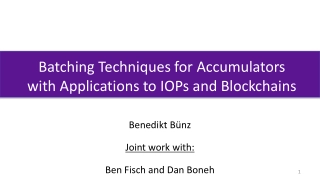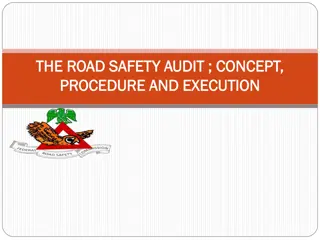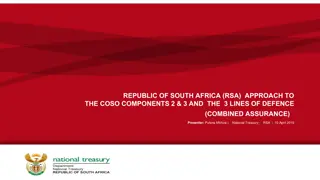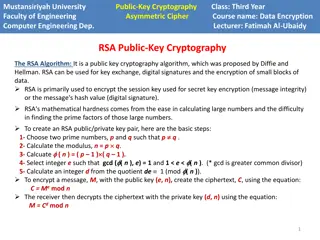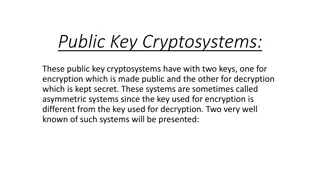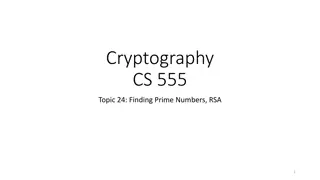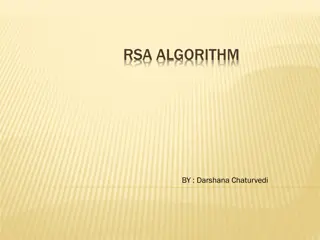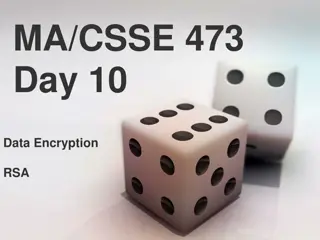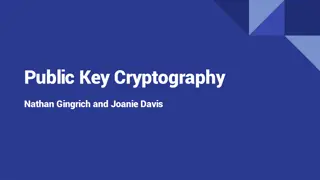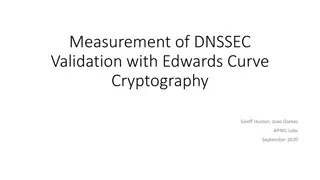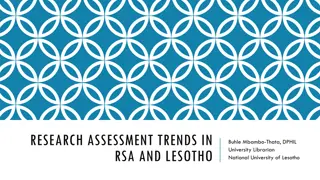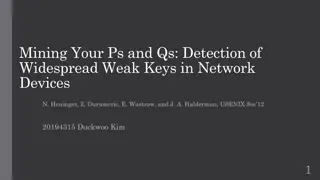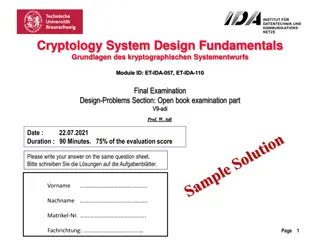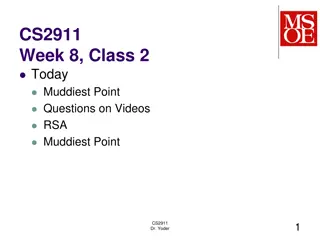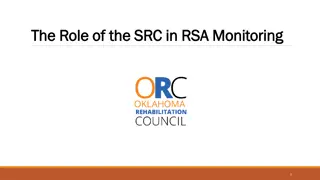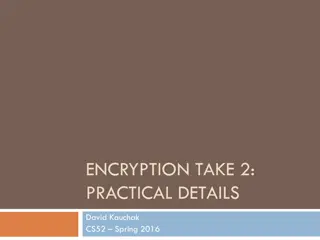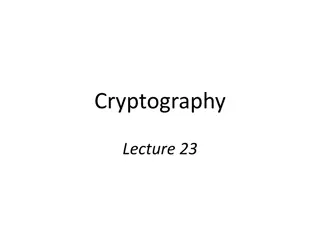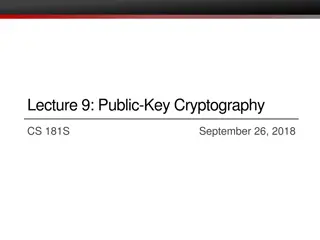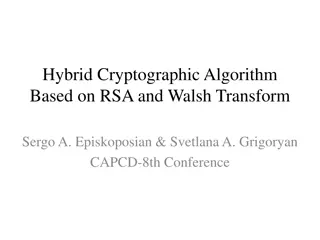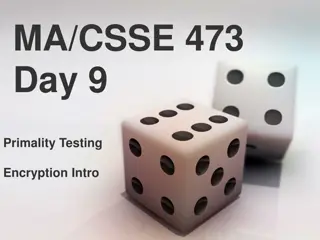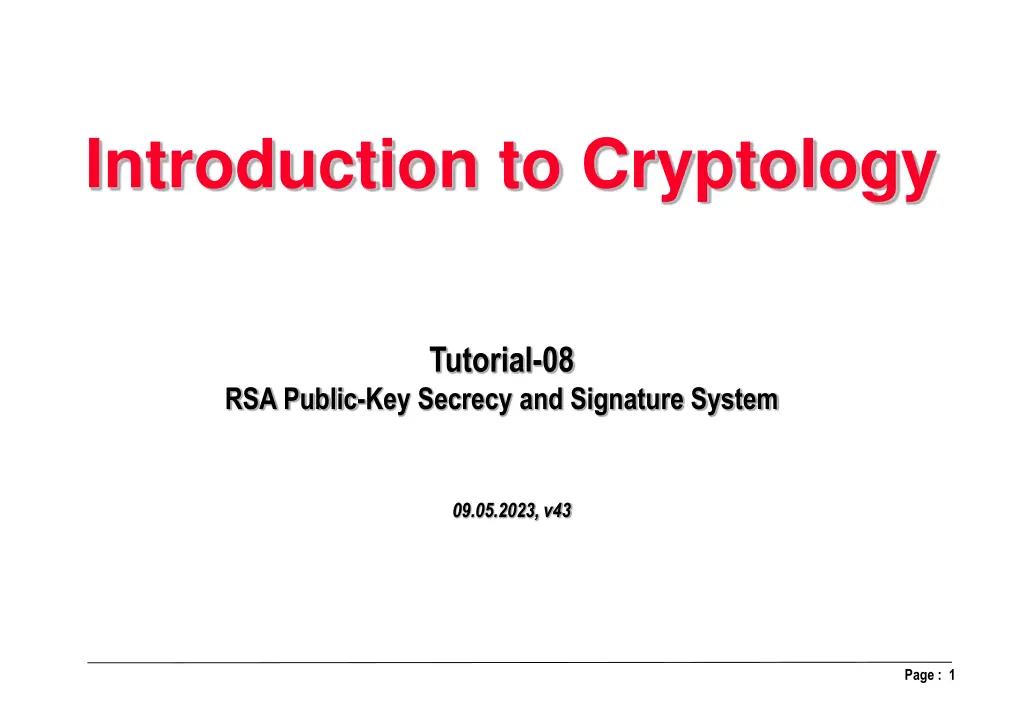
RSA Public Key Cryptography Tutorial
Learn about RSA encryption, decryption, and signature system in this comprehensive tutorial. Understand how to set up a public-key directory, encrypt messages, sign documents, and verify signatures using RSA algorithm. Practice solving problems to solidify your understanding of RSA cryptosystem.
Download Presentation

Please find below an Image/Link to download the presentation.
The content on the website is provided AS IS for your information and personal use only. It may not be sold, licensed, or shared on other websites without obtaining consent from the author. If you encounter any issues during the download, it is possible that the publisher has removed the file from their server.
You are allowed to download the files provided on this website for personal or commercial use, subject to the condition that they are used lawfully. All files are the property of their respective owners.
The content on the website is provided AS IS for your information and personal use only. It may not be sold, licensed, or shared on other websites without obtaining consent from the author.
E N D
Presentation Transcript
Introduction to Cryptology Tutorial-08 RSA Public-Key Secrecy and Signature System 09.05.2023, v43 Page : 1
Design Summary for RSA Public Key Secrecy and Signature Open directory USER A: USER B: User A Na Ea Na= pa* qaopen modulus of A pa* qatwo secret large primes (Na) = (pa-1)*(qa-1) Nb= pb* qbopen modulus of B pb* qbtwo secret large primes (Nb) = (pb-1)*(qb-1) User B Nb Eb Ea= open Encryption key of A Da= Ea-1 [mod (Na) ] gcd [Ea, (Na) ] = 1 Eb= open Encryption key of B Db= Eb-1 [mod (Nb) ] gcd [ Eb, (Nb) ] = 1 A sends to B: EbDb Db Eb Y = M mod Nb= M (Decrypt) Y = M (Encrypt) A signs Document M for B: Da mod Nb DaEa (M,S) Ea M mod Na = S = M mod Na = M (Verify M = M)? S Signed Message If M = M then the signature is true Page : 2
Problem 8-1: 1. Set up an RSA Public-key directory for two users A and B using the prime numbers 7,3 and 11,3 respectively. Use the open keys 5, 3 for A and B respectively. 2. User A Encrypts the message M = 6 to get the cryptogram YAand singes YA to generate SA andsends both cryptogram YAand signature SAto B. 3. Let user B verify the signature of A and decrypt the message. Solution 8-1: 1. System set up Open directory USER A: USER B: User A Na = 21 Ea= 5 Na= pa* qa= 7*3 = 21 open modulus of A pa* qa= 7, 3 two secret primes (Na) = (pa-1)*(qa-1) = (7-1)(3-1) = 12 Nb= pb* qb= 11*3 = 33 open modulus of B pb* qb= 11,3 two secret large primes (Nb) = (pb-1)*(qb-1) = (3-1)(11-1) = 20 Ea= open Encryption key of A = 5 Da= Ea-1 [mod (Na) ] = 5-1mod 12 = 5 Eb= open Encryption key of B = 3 Db= Eb-1 [mod (Nb) ] = 3-1mod 20 = 7 User B Nb= 33 Eb= 3 gcd [Ea, (Na)] = 1, gcd [5,12] = 1 gcd [ Eb, (Nb)] = 1, gcd [3,20] = 1 2. Encryption M = 6 to B: YA = MEb mod Nb = (6)3 mod 33 =18 Signing M = 6 by A: SA = (YA)Da mod 21 = (18)5 mod 21 =9 => (YA, SA) = (18,9) is sent to B 3. Sinature verification by B: YA = (SA)Ea mod 21 = (9)5 mod 21 = 18 = YA=> A is authentic Decryption by B: M = YADb = (18)7 mod 33 =6 Page : 3
Problem 8-2: 1. Set up an RSA Public-key directory for two users A and B using the prime numbers 11,5 and 23,3 respectively. Use the open keys 7, 5 for A and B respectively. 2. User A encrypts the message M = 2 to send the cryptogram YAto B and signs M to generate his signature SA. Compute YAand SAsent to B. 3. Decrypt the message at user s B site and verify user A s signature SA. User B signs the received message and sends it back to A. Compute his signature SB. 4. In 2, M can be revealed by any other user by decrypting SA using the open key Ea. Propose a possible solution to counteract that possibility and keep M secret. Solution 8-2: 1. System set up Open directory USER A: USER B: User A Na = 55 Ea= 7 Na= pa* qa= 11*5 = 55 open modulus of A pa* qa= 11, 5 two secret primes (Na) = (pa-1)*(qa-1) = (11-1)(5-1) = 40 Nb= pb* qb= 23*3 = 69 open modulus of B pb* qb= 23,3 two secret large primes (Nb) = (pb-1)*(qb-1) = (23-1)(3-1) = 44 Ea= open Encryption key of A = 7 Da= Ea-1 [mod (Na) ] = 7-1mod 40 = 23 Eb= open Encryption key of B = 5 Db= Eb-1 [mod (Nb) ] = 5-1mod 44 = 9 User B Nb= 69 Eb= 5 gcd [Ea, (Na)] = 1, gcd [7,40] = 1 gcd [5,44] = 1 gcd [ Eb, (Nb)] = 1, 2. Encryption M = 2 to B: YA = MEb mod Nb = (2)5 mod 69 = 32 Signing M = 2 by A: SA = (M)Da mod 55 = (2)23 mod 55 = 8 => (YA, SA) = (32,8) is sent to B Page : 4
Solution 8-2 cont.: 3. Decryption by B: M = YADb = (32)9 mod 69 = 2 Sinature verification by B: M = (SA)Ea mod 55 = (8)7 mod 55 = 2 = M => A is authentic Signing M = 2 by B: SB = (M)Db mod 69 = (2)9 mod 69 = 29 => (SB) = 29 is sent to A 4. One possibility is to encrypt Saas well using Eb. That is YSa= (Sa)Eb= 85mod 69 = 13. User B can then decrypt YSato get the signature and then check it.. Page : 5
Problem 8-3: A RSA system using the public modulus m = 1243. The public encryption key was 27. It was possible through a security gap in the computer operating system to find out that Euler function is 1120. 1. 2. Solution 8-3: Compute the two prime factors p and q of m Break the system and decrypt a received cryptogram Y = 7 (m) = (p -1)(q -1) = m-p-q+ s = (p + q) = m - (m) + 1 s = 1243-1120+1 = 124 m = p * q = 1243 1. p or q = ( s s2- 4 m ) / 2 = ( 124 + 1242- 4 x 1243 ) / 2 2. Decryption if the open encryption key E = 27: D = E-1 mod (m) that is D = 27-1 (mod 1120) = 83 [27-1 is computed by the extended gcd algorithm gcd(1120,27) = 1 ] => 27-1 = 83 p = 113, q = 11 M = YD = (7)83 mod 1243 = 662 Page : 6
Problem 8-4: A RSA cryptosystem with two users A and B having the secret prime number pairs for A: 13 and 7 and for B: 17 and 3 is used. 1. Find out the adequate open key of user A from the following list of integers: [21, 18, 11]. Compute the corresponding secret key for user A. 2. Find out the adequate open key of user B from the following list of integers: [26,21,22]. Compute the corresponding secret key for user B. 3. User B encrypts the message M = 3, and send the resulting cryptogram YAto A. User B then signs the cryptogram YAand generates the signature SB. Compute YAand SB. 4. Decipher the cryptogram YAon user A s site and verify the Signature SB. 5. User A signs the received message M and sends his signature SA back to B. Compute the signature SA. 6. How many open keys are possible for each user? Page : 7
Solution 8-4: 1. Find out the adequate open key of user A from the following list of integers: [21, 18, 11]. Compute the corresponding secret key for user A. NA = 13 * 7 = 91 , (NA) = (13-1)(7-1) = 72 gcd [ EA, (NA) ] = 1 => select 11 as gcd (72,11) = 1 EA = 11 DA = -13 mod 72 = 59 (see computation below) DA= 11 -1 mod 72 = - 13 = 72-13 = 59 n1 72 n2 11 b1 0 b2 1 q r 6 6 11 6 1 -6 1 5 6 5 -6 7 1 1 5 1 7 -13 5 0 2. Find out the adequate open key of user B from the following list of integers: [26,21,22]. Compute the corresponding secret key for user B. DB= 21 -1 mod 32 = - 3 = 32-3 = 29 n1 n2 32 21 NB = 17 * 3 = 51 , (NB) = (17-1)(3-1) = 32 gcd (EB, (NB) ] =1 => select 21 as gcd (32,21) = 1 EB = 21 DB = -3 mod 32 = 29 (see computation below) b1 0 b2 1 q r 1 11 21 11 1 -1 1 10 11 10 -1 2 1 1 10 1 3 -3 10 0 Page : 8
3. User B encrypts the message M = 3, and send the resulting cryptogram YAto A. User B then signs the cryptogram YAand generates the signature SB. Compute YAand SB. mod ) ( = A A N M Y = B S E D ( ) mod Y N A B A B (3) = = 11 (61) = = = 29 29 mod 91 61 Y mod 5 1 (10) 28 S A B 4. Decipher the cryptogram YAon user A s site and verify the Signature SB. Decryption: Verification: = E check : if ( ) mod mod S N Y N B B B A B D = ( ) mod M Y N A A A = 29 21 ( 61 ) mod 5 1 61 = mod 51 (3 = 11 59 609 mod 3 2 ) mod 91 6 1 mod 5 1 10 = M 1 6 1 mod 5 1 10 = = 649 mod 72 1 M 3 mod 91 3 10 = signature = 10 is authentic! 5. User A signs the received message M and sends his signature SA back to B. Compute the signature SA. mod ) ( = A A N M S D A (3) = = 59 mod 9 1 61 S A 6. How many open keys are possible for each user? # of keys for user A = [ (NA)] = (72) = (2*2*2*3*3) = 72 (1 -1/2) (1 1/3) = 24 keys # of keys for user B = [ (NB)] = (32) = (25) = 32 (1 -1/2) = 16 keys Page : 9
Problem 8-5: Assume having a setup of RSAcryptosystem with two peers Alice (A) and Bob (B) having the secret prime number pairs (11,23) and (31,7) respectively. 1. Choose the appropriate open keys EAand EBfrom the following lists. List (A ) = {11, 220, 37} and list (B) = {9,22,11} respectively. Compute the corresponding secret keys DAand DB respectively. 2. Bob enciphers the message M = 12 which should be sent to Alice as the cryptogram CB. In a further step Bob signs M3to generate the signature SBand sends it to Alice. Calculate CB and SB. 3. Decipher the cryptogram CBonAlice s side. 4. Verify the signature SBonAlice s side. 5. Alice signs the value M3mod NAand sends her signature SAback to Bob. Calculate the signature SA. Verify SAon Bob s side. 6. How many public key pairs are selectable forAlice and how many for Bob. 7. Why is the system not secure if M is signed instead of M3? Page : 10
Solution 8-5: 1. Set up Alice NA = 11 * 23 = 253, (NA ) = (11-1)(23-1) = 220 gcd [ EA, (NA ) ] = 1 => select 37 as gcd (220,37) = 1 EA = 37 DA = -107 mod 220 = 113 (see computation below) DA= 37 -1 mod 220 = -107+220 = 113 a1 a2 b1 b2 q 1 0 0 1 5 0 1 1 -5 1 1 -1 -5 6 17 -1 18 6 -107 2 GCD m 220 37 35 2 u 37 35 2 1 r INVERSE VALUE 35 2 1 0 1 INVERSE= -107 GCD= Set up Bob NB = 31 * 7 = 217 , (NB) = (31-1)(7-1) = 180 gcd (EB, (NB ) ] = 1 => select 11 as gcd (180,11) = 1 EB = 11 DB = -49 mod 180 = 131 (see computation below) DB= 11 -1 mod 180 = -49 + 180 = 131 a1 a2 b1 b2 q 1 0 0 1 16 4 0 1 1 -16 2 1 -2 -16 33 1 -2 3 33 -49 3 GCD m 180 11 4 3 u 11 4 3 1 r INVERSE VALUE 3 1 0 INVERSE= -49 GCD= 1 Page : 11
Solution 8-5 cont.: 2. Encryption M = 12 toAlice: ( B C M C = Signing M3by Bob: ( B S M S = = = 3 E D ) mod ) mod N N A B A B = = 37 3 131mod180 (12 ) (12) mod253 243 mod217 209 B B 3. Decription by Alice: = = = = 113 D ( ) mod (243) mod253 12 M C N M A B A 4. Signature Verification by Alice: = E check if: ( ) mod S N M = B B B = = = 11 3 3 (209) mod217 209 mod 12 mod217 signature is authentic! M N B 5. = = = = 3 3 113 D ( ) mod (12 ) mod253 188 S M N S Signing M3 by Alice: A A A A ) = = = 3 37mod220 E mod signature is authentic! ( mod (188) mod253 210 M = N S N Signature Verification by Bob: 12 mod253 = A A A A = 3 3 mod M N A 6. # of keys for user A = [ (NA )] = (220) = (22 * 5* 11) = 220(1 1/2) (1 1/5)(1 1/11) = 80 keys # of keys for user B = [ (NB )] = (180) = (22 * 32 * 5)= 180(1 1/2) (1 1/3) (1 1/5) = 48 keys Page : 12
Solution 8-5 cont.: 7. The system is unsecure as If A or B sign M, as the public key of the sender allows anybody to reveal M, that is M is not kept secret Signing an exponentiated version of M makes this kind of attack impossible, because the attacker will get a value that correspond to M3mod N and there is no algorithm to compute the Cubic root modulo a composite m without factoring N (as in Rabin-lock). That is, if the prime factors p and q for N are not known then M3mod N is a one-way function (N = p*q) if p and q are not known. Page : 13 3 M

